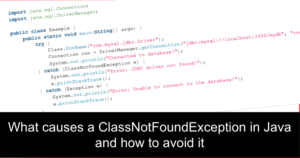What causes a NoSuchMethodError in Java
In our article “5 Common errors you may see in Java Stack Traces and how to avoid them“, we took a quick look at the NoSuchMethodError; in this article, we discuss what causes this exception and how you can avoid it.
A NoSuchMethodError in Java occurs when a class does not have a method with a specific name and parameter types that is being called. This can happen if the class has been compiled with a different version of the method, or if the class is not being loaded correctly. The error typically occurs at runtime and can be challenging to diagnose and fix.
An example of how a NoSuchMethodError might occur in a Java program:
public class Example {
public static void main(String[] args) {
MyClass myObject = new MyClass();
myObject.myMethod("hello"); // this method does not exist in MyClass
}
}
class MyClass {
public void myOtherMethod(String s) {
System.out.println(s);
}
}
In this example, the main method is trying to call the method myMethod on an object of type MyClass, but myMethod does not exist in the MyClass class. When the program is run, it will throw a NoSuchMethodError with the message: “No such method: MyClass.myMethod(java.lang.String)”
This error can be fixed by either adding the missing method to the class or changing the method call to a method that does exist in the class.
How to fix NoSuchMethodError in Java
- Make sure that the class you are trying to call the method on is being loaded correctly. This can include checking that the class is in the correct package and that the classpath is set correctly.
- Make sure that the method you are trying to call exists in the class and that the method signature (name and parameter types) is correct. You may need to change the method name or the parameter types to match the correct method.
- Make sure that the class and its dependencies are compiled with the same version of the Java SDK.
- Use a build tool like maven or gradle that manage dependencies and version for you.
- Use a dependency management tool like jdeps or classycle to check for missing dependencies or conflicts.
- Clean and rebuild your project to make sure that the class files are being regenerated with the correct dependencies and versions.
- Make sure that you are using the correct version of the library.
By following these steps, you can ensure that the class and its methods are being loaded and called correctly, and that any dependencies are being handled properly, which can help prevent NoSuchMethodError from occurring.
How to find a NoSuchMethodError in Java
The first step in finding a NoSuchMethodError is to check the printed stack trace when the error is thrown. The stack trace is a report of the sequence of method calls that led to the error, starting with the method that caused the error and going back to the initial method call. The line number and class name of the method that caused the error will be provided in the stack trace, which can help you locate the source of the error.
Another important step is to check the classpath of your Java application. The classpath is a list of directories and JAR files that the Java Virtual Machine (JVM) uses to search for classes and resources. If the classpath is not set correctly, the JVM will not be able to find the class or resource it needs, and a NoSuchMethodError will be thrown. To check the classpath, you can use the command echo %CLASSPATH% on Windows or echo $CLASSPATH on Linux and Mac.
If you cannot find the source of the error using the stack trace and classpath, you can use a debugger to step through the code and see where the error is occurring. A debugger is a tool that allows you to execute your code line by line and see the values of variables at each step. This can help you locate the source of the error by showing you exactly where the error occurs in the code.
An APM (Application Performance Management) tool can be used to find and diagnose a NoSuchMethodError in a Java application. The specific steps may vary depending on the APM tool you are using, but generally, you would follow these steps:
- Set up the APM tool to monitor your Java application. This may involve installing an agent on the server where the application is running or configuring the application to send performance data to the APM tool.
- Look for any alerts or notifications from the APM tool indicating that a NoSuchMethodError has occurred. Some APM tools will automatically send notifications when they detect an error, while others will require you to check for errors in the tool’s interface manually.
- If a NoSuchMethodError has occurred, use the APM tool’s tracing and logging features to investigate the error. These features will allow you to see the specific method that is causing the error, as well as any related information such as the method’s arguments and the stack trace.
- Use the APM tool’s profiler to identify any performance issues that may be contributing to the NoSuchMethodError. Profiling can help you identify any bottlenecks or slowdowns in your application that may be causing the error to occur.
- Use the APM tool’s debugging features to fix the NoSuchMethodError. This may involve making changes to the code of the application or adjusting the configuration of the application’s runtime environment.
- Once the error is fixed, use the APM tool to verify that the problem is resolved and that the performance of the application has improved.
Conclusion – What causes a NoSuchMethodError in Java and how to avoid it
This article explains why a NoSuchMethodError in Java occurs when a class does not have a method with a specific name and parameter type that is being called. This can happen if the class has been compiled with a different version of the method or if the class is not being loaded correctly. The error typically occurs at runtime and can be challenging to diagnose and fix. In other articles, we look at other common Java Exceptions, including; How to fix an Array Index Out Of Bounds Exception in Java, and What Causes java.lang.OutOfMemoryError.



